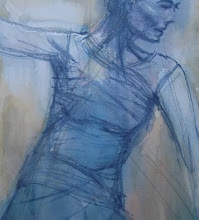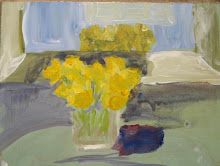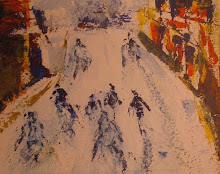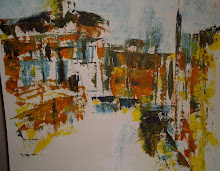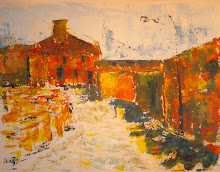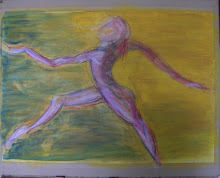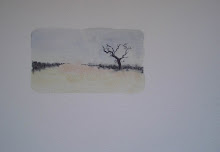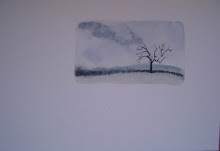When I heard that J was ill, seriously ill, there was a need to paint. And a new sheet of watercolour paper was painted with vermillion hue -- it seemed to say something about her energy and love of life. Nothing happened to the painting; the painted sheet stayed on my drawing board on the easel for several weeks.
In the third art class, we started a "project". We began by mind mapping on a large sheet of paper in the middle of which we were to write or to think "what do I like to draw?". At the time, this question came as a loud and shocking reminder that we don't need permission to enjoy. What do I like, not what do I have to do or what should I do! It's okay to do something because I like doing it -- and actually I ought to do it just because I like doing it, and I'm likely to do it really well because I like doing it. (How to make this happen at work too?) Anyway, my mind map took in: the pleasure of drawing beautiful Greek statues, not as stone but as somehow alive; the lively beauty of the Roman pots and vases in the museum in Spain, placed on a shelf in a way that made them dance; and the beauty of the Latin writing inscribed in stone that could be read after 2000 years. I suppose there's a link with J. somewhere -- about human connections across time and through stone; we none of us survive physically but only through shared aesthetics and meanings. What we do or write or make may stay around and connect us to the future, even to future people not yet born; and this does nothing to take away present pain.
I pursued what was started in class by getting out books about Greek and Roman statues, old drawings. In one book there's a photograph of statues stacked in a museum in Lyon. There's a head at an angle raised to the light that gives a feeling of exultation or agony, a man's head and body that display strength and power, and in the background, other busts watching like an audience. Just as the little vases in the museum became a piece of art by accident, so this photograph is a beautiful picture as if by chance. I did a quick rough drawing to get the feel of where things were. Then I used yellow and green acrylic paint on top of the vermillion, and the pencil I love best -- Indigo watercolour -- to scratch through the paint, draw on the paint and mix with the paint. As usual, I was frustrated by some details, especially in the mouth and nose of the foremost head, and working on it lost some of the spontaneity of other parts of the painting.
Today as I vacuum cleaned underneath the easel, I decided it needed more layers and that I still want to try those dancing vases on the glass shelf in the museum -- and I think in the photograph is also an image of me reflected in the glass case in front of them -- layers across time. So I've added a wash of vermillion hue, very wet, over the painting but of course some of the yellow was so beautiful I didn't want to lose it, so I took out bits of the vermillion wash. I'll add another wash and then leave it until after my holiday.
Tuesday, 8 July 2008
Sunday, 6 July 2008
Accuracy, beauty, truth
We had a brief discussion about accuracy, beauty and truth. In a research workshop the previous week, we had discussed how analysing data requires creativity and inspiration even though most people don't like to admit it. But it's not just that any kind of ideas will help, it's a very skilled kind of creativity that notices what's there in the data that might matter and pulls it out. In the art class, the teacher disagreed with us when we said we wanted to be able to draw "accurately"; she wanted us to make "beautiful" marks and not to lose creativity in trying to accurately represent. My frustration is in not being able to make the kind of mark that I find beautiful -- it happens sometimes but I'd like it to be much more skilled and reliable.
We agreed that what we wanted to see in our pictures was some kind of "truth" about what we were painting, and that's what I was trying to get at in "accuracy".
I think there's a great commonality between achieving this in one's art and achieving it in the kind of research that I do. Both require mastery of technique combined with imagination and being open to possibilities.
We agreed that what we wanted to see in our pictures was some kind of "truth" about what we were painting, and that's what I was trying to get at in "accuracy".
I think there's a great commonality between achieving this in one's art and achieving it in the kind of research that I do. Both require mastery of technique combined with imagination and being open to possibilities.
The last class of the year
We drew portraits and I tried to make the watercolour pencils create tone. I love the effect of just a little colour in a line drawing, creating shadow and highlights as if by accident. Getting it in the right place, or in a good place, is my current challenge. The blue one worked reasonably well, although the model is at no risk at all of being identified from this picture!
Clouds
Oh, a whole month without blogging -- it was a busy month is my only excuse. People coming and going, work events that made me miss two of the five drawing classes this half term, planting a garden. And quite some effort spent resisting misery.
One goal achieved -- the Rape Field painting, mounted and framed, was hung in a local exhibition.
In one class, we painted and drew clouds. First, just playing with materials and techniques, and then going outside to draw what was there. We've done a lot with various types of soluble pencils -- sometimes these produce nice effects, like rain out of a cloud, and other times they just annoy me because they're too small and fiddly. At home, I sat in the window seat and used watercolour pencils to paint the clouds over the pond. A couple of weeks after, I dashed to the seaside and spent some hours painting clouds over the Solent. They were yachts everywhere and I added some with my thin pen trying to get their jaunty movements. I took a photograph from where I was sitting, and am amused by how different the proportions are -- the little tiny strip of land has come out as quite mountainous in my painting.
One goal achieved -- the Rape Field painting, mounted and framed, was hung in a local exhibition.
In one class, we painted and drew clouds. First, just playing with materials and techniques, and then going outside to draw what was there. We've done a lot with various types of soluble pencils -- sometimes these produce nice effects, like rain out of a cloud, and other times they just annoy me because they're too small and fiddly. At home, I sat in the window seat and used watercolour pencils to paint the clouds over the pond. A couple of weeks after, I dashed to the seaside and spent some hours painting clouds over the Solent. They were yachts everywhere and I added some with my thin pen trying to get their jaunty movements. I took a photograph from where I was sitting, and am amused by how different the proportions are -- the little tiny strip of land has come out as quite mountainous in my painting.
Subscribe to:
Posts (Atom)
